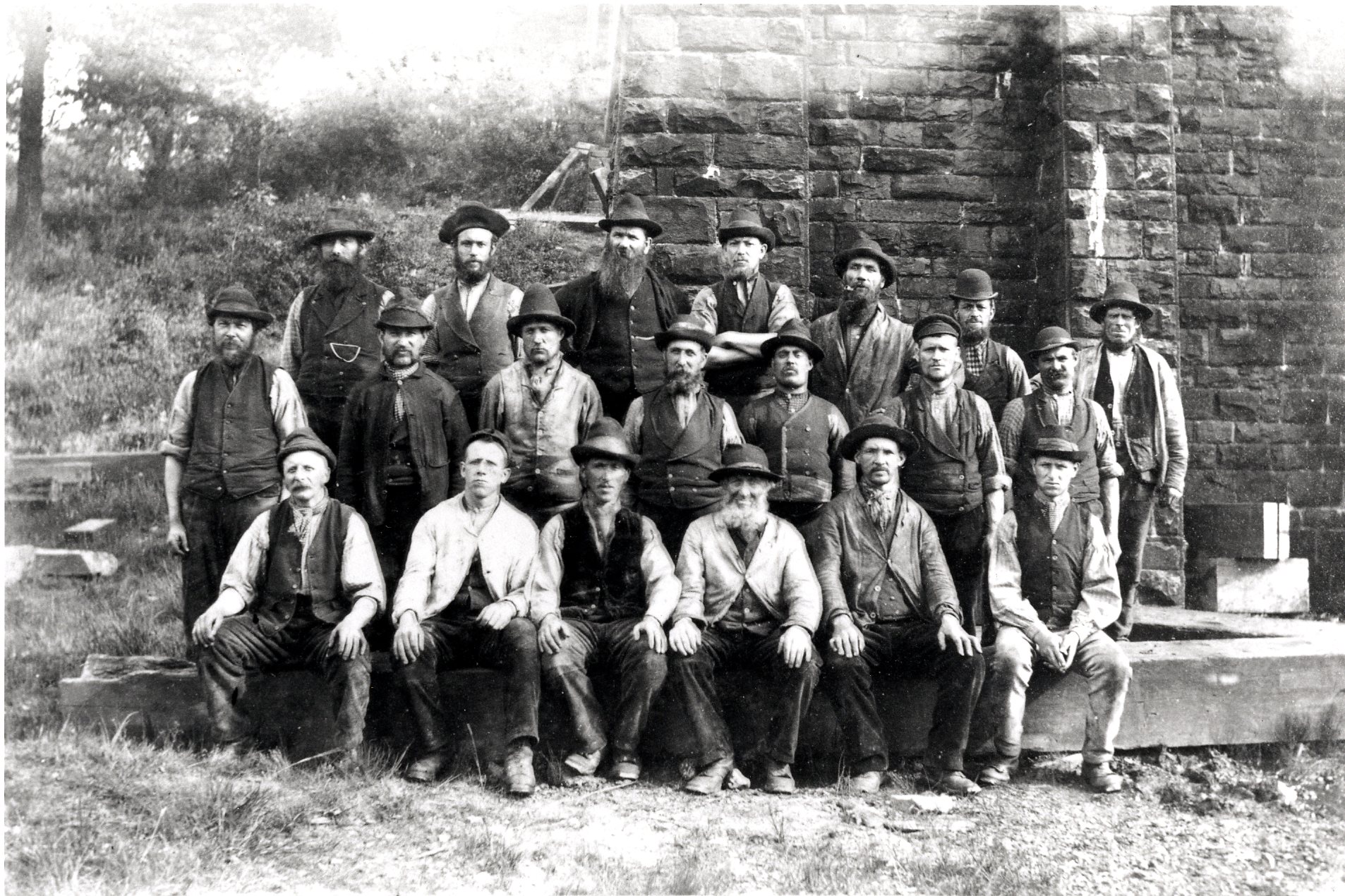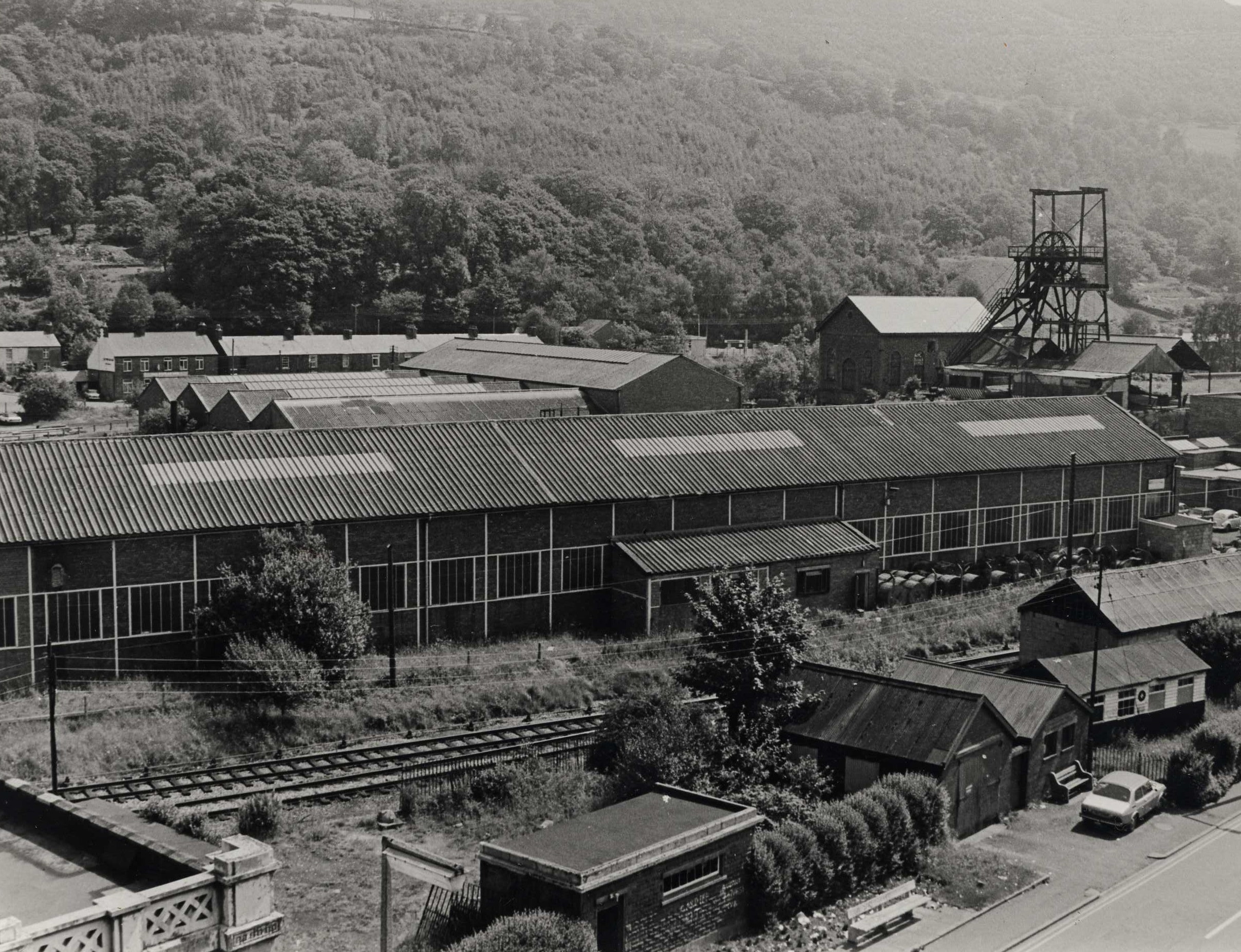This blog will take you on a whistle-stop tour of the valley’s railways via photographs from the Cynon Valley Museum collection. This includes some railway ‘outposts’, an example of railways and the coal industry and the valley’s largest and most impressive station, built at Abercynon.
Gamlyn Viaduct

Workmen on the Gamlyn Viaduct. (ACVMS:2000.436)
Let us begin with this superb image depicting the ‘navvies’ or navigators who built the countries railway network from the 1820s to the beginning of the 19th century and beyond. The photographer Joseph Lendon Berry (1833-1916) took this image during the construction of the viaduct. The ‘navvies’ were typically recruited from Ireland for the extremely hard work and would spend many years travelling all over Great Britain from contract to contract. There is nothing immediately evident here to suggest these men were Irish, but it is likely. The Gamlyn viaduct was made mainly from wood, so it is probable that some of these men were skilled carpenters.
In 1854/55 the renowned engineer Isambard Kingdom Brunel constructed the Gamlyn viaduct (one of two in the Cynon Valley) by the Vale of Neath Railway on the Dare and Aman branch. These Cynon Valley viaducts are examples of wooden fan-style viaducts constructed in Cornwall and Wales. They were the last two viaducts of this type to be demolished. The double line was a feature of Barlow rail, which was somewhat unusual at that time for broad-gauge railways. The Barlow rail did not last long and a standard gauge track was laid which remained until the line’s closure. The Gamlyn and Dare viaducts were a fan of trestle design. They measured just over 600 feet (183 metres) long and 70 feet (21.3 metres) high. The bases of the viaduct are built of bulldozed sandstone, the highest being 23 feet (7 metres).
The Vale of Neath Railway Company built The Aman-Dare branch which quickly became incorporated into the Great Western Railway (GWR). The line ran from Gelli-tarw junction on the mainline from Neath to Merthyr Tydfil over the Gamlyn viaduct and then parallel with Aberdare Park. It then crossed the Dare viaduct and joined the line for Bwllfa colliery to Cwmaman. Generally the line trafficked coal from the various collieries to the mainline and to the various South Wales docks. However, miners also travelled back and forth on this line.
There are also reports that the line was also used to convey Sunday school groups to the seaside as the late 1930s. An interesting incident is recounted in John Mear’s superb book ‘Aberdare: The Railways and Tramways’. The GWR asked organisers of a Sunday School coast trip to embark the children at Black Lion halt on Monk Street and walk to the High-Level station to re-join the train. This was so the train would reduce its weight, thus reducing the risk over the fragile Dare and Gamlyn viaducts. However, the Sunday School organising committee won the day and the children were safely convoyed across both viaducts without incident. Modern-day health and safety regulations may have something to say about that scenario occurring today!
The men in the photograph above are sat on one of the many large wooden timbers used in the construction of the Gamlyn viaduct. There are 20 men here, all displaying a wide variety of headwear popular in the mid-19th century. It can be reasonably assumed that their trousers would have been corduroy which was popular amongst the navvies due to strength and durability. The men appear to be older which would indicate that they were experienced railway workers who had constructed many miles of railways previously.
The viaduct closed to traffic on the eve of the Second World War, the 1st of September 1939, but remained in situ until 1947. The wooden bulk of the structure was removed, leaving only the masonry piers still in place to this day. The embankments on each side of the viaduct are still easily noticeable and each of the piers can still be seen crossing the Cynon. The Dare and Gamlyn viaducts were fantastic examples of Brunel’s genius and have the distinction of being the final two wooden examples to be dismantled, a fact that the Cynon Valley should be proud of.
Cwmaman Crossing Halt

Cwmaman Crossing Halt (ACVMS:2009.214)
Next we will go on to one of the railway outposts of the valley. Staying on the Vale of Neath’s Dare and Aman branch, we move along the top of the valley to the village of Cwmaman. This photograph shows two Great Western Railway employees in the doorway of the small booking office at Cwmaman Crossing Halt with several potential passengers. John Mear in his book ‘Aberdare: The Railways and Tramroads’ explains that although it carried the prefix ‘Halt’, by definition a Halt is an unmanned stop, so therefore Cwmaman Crossing could legitimately have called itself a station with its staff evident here. Note as well the local advertising for ‘J K Lewis Family Grocers’ who ran a shop in Cwmaman.
The Dare Aman branch line opened in 1855; however, until 1906 the only traffic seen on the line was mineral, mainly coal. In 1903 the GWR began a service from Black Lion Halt (Monk Street, Aberdare) to Cwmaman Colliery for miners, who were given a brass token to exchange for travel. The Aberdare Leader reported on the 6th of January 1906 about a ‘Motor Service between Aberdare and Cwmaman’. The company began a service for all between the Black Lion Halt and Cwmaman with the intermediate stops listed as Tonllwyd Halt, Godreaman Halt and Cwmneol Halt. The article goes on to say that, ‘The fares are very reasonable. The single fare between the two terminuses will be 2d and the return fare 3d.’ How much is a return from Cwmaman to Aberdare today?
The service never really became that popular and the introduction of a reliable motorbus service, firstly by the GWR themselves and then later in 1929 when they amalgamated their bus services with the Western Welsh Omnibus Company, meant that shortly afterward the passenger service ceased. The line was closed, as mentioned above, for good in 1939; however, the route of the line has remained and has now become a great favourite with dog walkers and cyclists.
The Navigation Yard, Mountain Ash

Navigation Colliery, Mountain Ash and old Taffs Vale Railway Station (ACVMS:2000.1025)
We move down the valley now to Mountain Ash. The ‘Navi’ yard was for many years one of the arteries that linked the two sides of the town together, making it far easier for people living in Newtown or Caegarw to cross the valley here to do their shopping down the ‘Mount’. This photograph dates from the 1970s when the line was only open for mineral traffic after passenger services ceased in 1964. The yard was a part of the Nixon’s Navigation colliery which was first sunk in 1855 by John Nixon, a mining pioneer from the North-East of England. However this blog is mostly focused on the railways of the Cynon Valley, so let us return to the tracks. The line in the foreground of this photograph is the Taff Vale Railway mainline from Cardiff Bute Road to Aberdare Low Level.
The previous photographs have all been part of the Vale of Neath Railway and latterly the Great Western Railway; however, the railway depicted in this photograph was opened by the Aberdare Railway Company on the 6th of August 1846. The running of the line was undertaken by the Taff Vale Railway (TVR), who went on to take the lease of the line in 1847 with the Aberdare Railway Company being incorporated into the TVR. The line continued to be served by the TVR until grouping in 1923 when the hundreds of private railway companies in Great Britain were reduced to the ‘Big Four’: namely the Great Western Railway (or the Great Way Round, as critics called it), London, Midland and Scottish Railways, The Southern Railway and the London North Eastern Railway Company. On the nationalisation of the railway network in 1948, control of the line moved to British Railways, Western Region. The line closed to passenger service in 1964 with much of the line being singled and remained open for only mineral traffic and the very occasional summer excursion.
The Nixon’s Navigation colliery officially closed in 1940. However, the yard remained open as a maintenance depot and to be used for pumping.
The yard has featured in local newspapers on many occasions throughout the years and many of the stories have been tales of woe. One of these sad stories appeared in the Aberdare Leader on 30th November 1878. It reports that a stoker (fireman), by the name of Charles Davies, was killed at the yard when he hit his head on a post while his engine was in motion. On 19th December 1907, the Cardiff Times reports the death of Mrs Jane Garett (63) who was drowned in the Glamorganshire Canal near the Cresselly Inn after crossing the yard from her home in King Street, Miskin on her way to her daughters in Caegarw. The Cardiff Times again reports on 26th March 1870 the untimely death of an unnamed mason’s labourer who was crushed to death between coal wagons at the yard. Another stoker’s death was reported in the Western Mail on 5th April 1880 – on this occasion George Smith, aged 17, fell under the wheel of coal trucks at the yard. The paper reports that he was doing well until lockjaw set in and sadly he died.
Abercynon Station

Abercynon Railway Station (ACVMS:2009.213)
The end of the line for this railway-themed blog now approaches, so aptly we end at the valley’s last station, Abercynon. This superb image of Abercynon station looking towards Merthyr and Aberdare dates from around the late 1920s or early 1930s. Note the sign reminding passengers to change here for Aberdare. The Taff Vale Railway (TVR) opened the station, then known as Navigation House, on its mainline to Merthyr on October 9, 1840 for freight and passenger services. The Great Western Railway took over the running of all TVR lines and stations on grouping in 1923. It remained under their control until 1948 when the British railway network was nationalised and brought under the control of British Railways, Western Region.
To the right of this image was the steam shed. Prior to 1950 the shed’s code was ‘AYN’, afterward becoming ‘88E’ until its eventual closure in November 1964. The area around the station became a stabling point for several diesel class 37 locomotives until the late 1980s. Further reading on the locomotive allocation to Abercynon shed and many others in South Wales and beyond can be found at ‘Shed Bash UK’.
The station was downgraded in the early 1970s with only one face of the island platform being in use, serving the Merthyr to Cardiff service. For many years, the waiting passengers would notice their train stopping at the Cardiff end of the station to pick up and return the single line token for the Merthyr branch. The signal box that many of us in the valley would remember was a GWR type 27c box. The box started its life at Birmingham Moor Street in 1909, moving to Didcot Foxhall in 1915 and finally to Abercynon in 1932, where it stayed until its sad demolition in 2013 after five years of inactivity. The signalling for the entire area is now covered by the new Abercynon Signalling Centre directly opposite its predecessor.
The South and North experiment that lasted some 20 years ended in 2008. Abercynon North on the Aberdare line was closed and the line was rearranged, looking similar to the photograph above. The main station became just plain Abercynon, once again serving both Merthyr and Aberdare and using both its platforms once again.
Geraint Lewis, Cynon Valley Museum volunteer, June 2020
Further reading:
- More about the Gamlyn Viaduct on Coflein and Ancient Monuments
- The Railway: British Track Since 1904, Andrew Dow.
- About timber viaducts on Engineering Times
- Cynon Valley History Society, Hanes 57, available online.
- Aberdare: The Railways and Tramroads, John F Mear, Anthony Rowe Ltd, Chippenham.
- Aberdare Leader 6th of January 1906, via The National Library of Wales available online.
- About Navigation Colliery on Welsh Coal Mines website
- Cardiff Times 30th November 1878, via the National Library of Wales available online.
- Cardiff Times 19th December 1903, via the National Library of Wales available online.
- Cardiff Times 26th of March 1870, via the National Library of Wales available online.
- Western Mail 5th of April 1880, via the National Library of Wales available online.
- Welsh Railways Research Circle- Available online.
- Shed Bash UK
- About the Abercynon Signal Box at Coflein
Thanks for reading!
We’re working hard to bring online content to you during this period of uncertainty. You can see some of these on our Exhibition at Home page. If you’d like to support the Cynon Valley Museum during this time, please share this post with your friends and family. You may also like to make a donation. We’re a registered charity and really appreciate your support. We are looking forward to welcoming everyone back to the museum as soon as possible.
Like this?
You might be interested in receiving Y Chwa/The Blast, a quarterly newsletter for the Friends of Cynon Valley Museum, which includes collection highlights, museum news, and similar articles to this. Click here to find out more about the Friends Group.
We’ve added the photographs in this blog post to our Museum Jigsaws page! Head over there to see if you can reconstruct the views in this article.





Very interesting indeed but the article is in dire need of proof reading as there are two clangers in the first four lines and many others later, including ‘Amman’. There is an Amman in West Wales but our local version is Aman. Sorry, I don’t mean to be harsh, but we must keep up the standard you know.
Good morning Bourke Le Carpentier,
Thank you for your comment, we appreciate your feedback. We are always striving to make our content better. We have given the article several proofreads and edited the spelling and grammar. We hope you enjoy the updated version.
Thank you,
Rhian, Museum Assistant
All very interesting but there used to be two railway stations in mountain ash the high level of the caegarw side of town and the low level station on the Oxford Street side of town the high level station seems to be something of an enigma and i would like to know what destinations were served by this station
Mountain Ash (Cardiff Road or High Level) was originally part of the GWR line from Neath to Pontypool Road, and onward into England. The Neath to Aberdare/Merthyr section was originally the Vale of Neath Railway.
Mountain Ash (Oxford Street or Low Level) was on the Cardiff to Aberdare line. Originally the Aberdare Railway, it ran from what is now called Abercynon to Aberdare, as a branch of the TVR Cardiff to Merthyr Tydfil line. The TVR took over the Aberdare Railway within a short time of its completion.